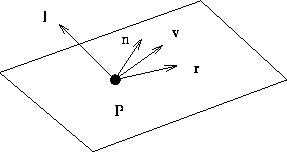Light, continued
Tom Kelliher, CS 320
Mar. 30, 1998
Announcements:
From last time:
-
Outline:
-
Assignment: Read Chapter 14.
- Simple spotlight: point source with light emitted only through narrow
range of angles.
- Consider the source at
 to be restricted by the cone
described by
to be restricted by the cone
described by  and
and  .
.
- For accuracy, distribution within the cone is modeled by
 .
.
- Re-calculating the
 --
-- vector.
vector.
- If the distance is ``large'' how much does the vector change?
- Replace source location with source direction:
- Near source:
 (a point)
(a point)
- Far source:
 (a vector)
(a vector)
- Flat shading: each point on a polygon assigned same color.
- Gouraud (smooth) shading: assign colors individually to vertices,
interpolate.
- Consider an object point,
 and a light source
and a light source  .
.
- Important vectors:

- l: vector to light source.
- n: surface normal.
- v: vector to COP.
- r: reflection vector.
- The light from source to object can be described by:

(theoretically wrong but, in practice, right)
- Using material properties, distance from source, orientation of
surface and direction of source a reflection matrix can be constructed:

- (Simplified) Illumination at
 :
:

A global ambient term may be ``thrown'' in.
Same at each point on a surface:

Repeat for each color.
- Diffuse surface brightest at noon, dimmest at dawn, dusk.
- Lambert's law: we see only the vertical component of light:

- If
 and
and  are normalized:
are normalized:

So:

- Specular reflection produces highlights.
- The smoother the surface (higher shininess) the narrower the range
of reflection angles.
- Reflectivity proportional to angle between viewer (
 ) and
perfect reflection (
) and
perfect reflection ( ):
):

where  is the shininess term:
is the shininess term:
- < 100 for objects with broad highlights.
- 100 to 500 for most metallic objects.
- Assuming normalized vectors:

Computed for each light source and each color:

- Outward facing normal must be specified for each vertex.
- Analytic surfaces: cross product of partial differentials
- Polygonal surfaces:
- Points of continuity.
- Points of discontinuity.
Thomas P. Kelliher
Sun Mar 29 21:47:30 EST 1998
Tom Kelliher
 to be restricted by the cone
described by
to be restricted by the cone
described by  and
and  .
.
 .
.
 to be restricted by the cone
described by
to be restricted by the cone
described by  and
and  .
.
 .
.
 --
-- vector.
vector.
 (a point)
(a point)
 (a vector)
(a vector)
 and a light source
and a light source  .
.



 :
:



 and
and  are normalized:
are normalized:


 ) and
perfect reflection (
) and
perfect reflection ( ):
):

 is the shininess term:
is the shininess term:

